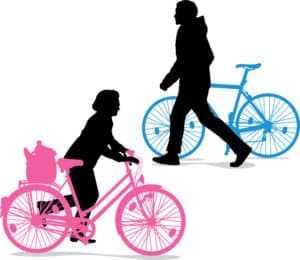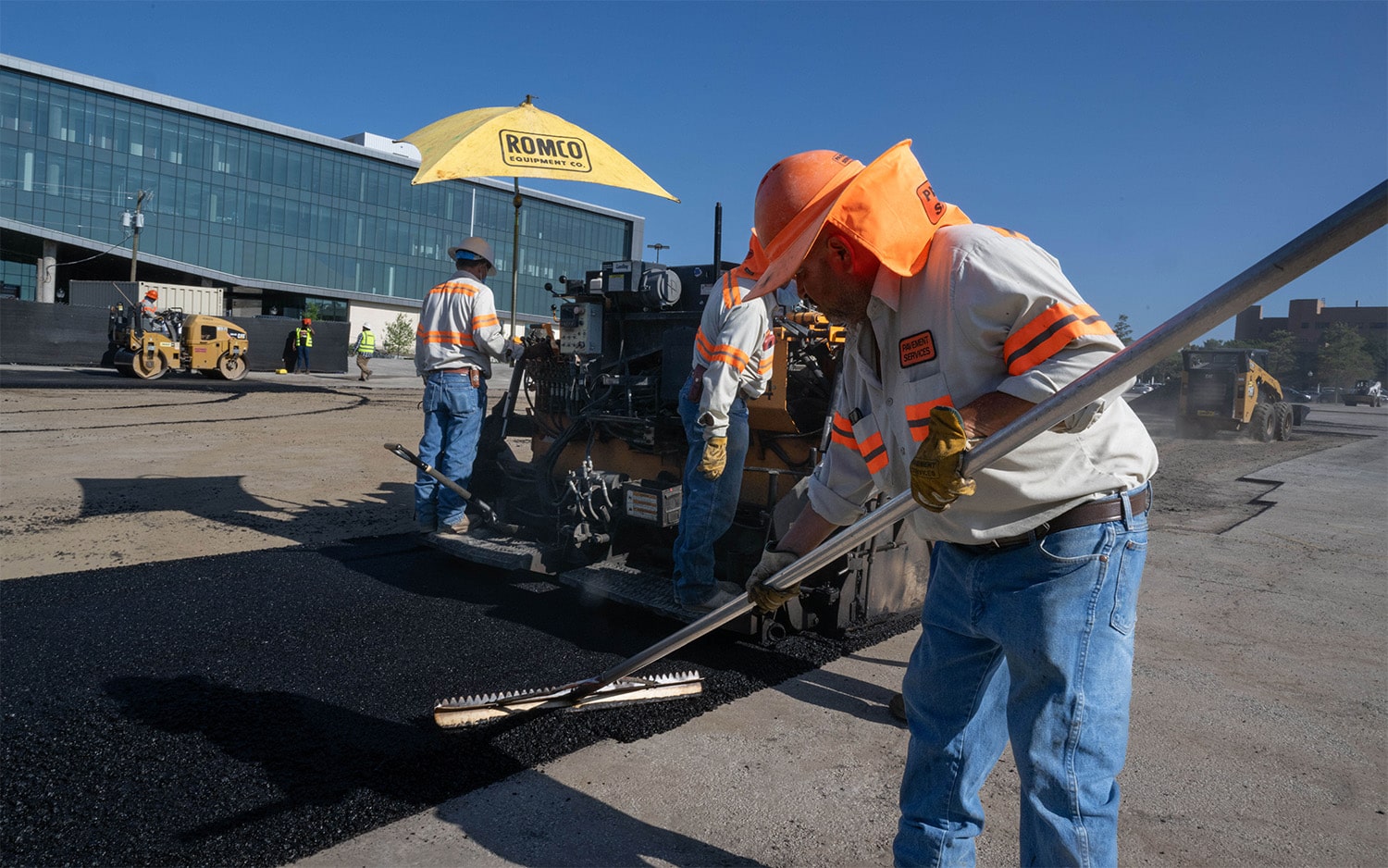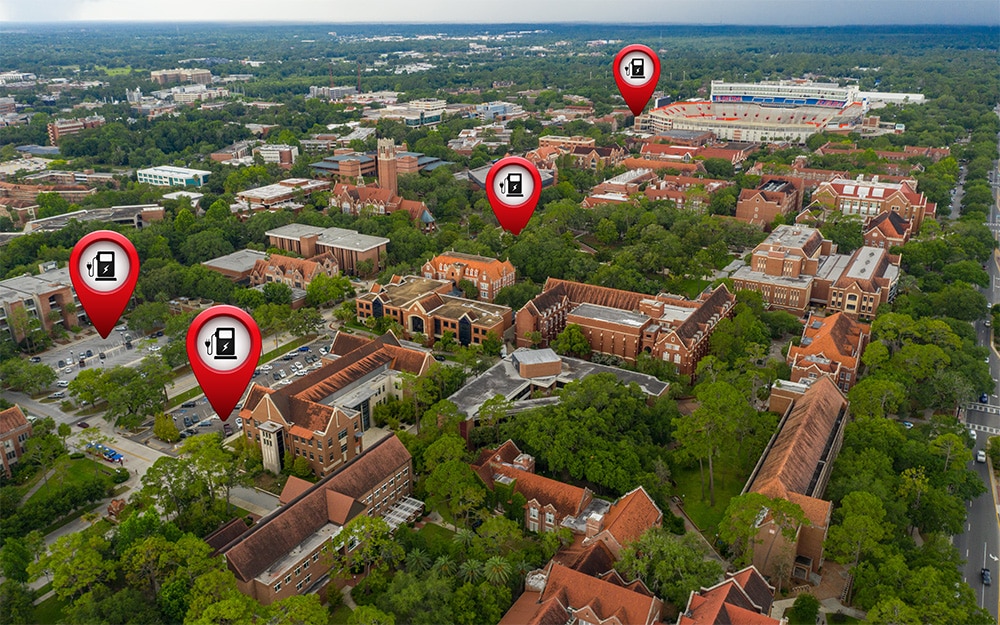
What innovation will have the most significant impact on parking and mobility in the next five years?
Innovations in AI, IoT, and 5G are set to revolutionize
Share:
Share:
In 2019, Texas A&M University was experiencing year after year of unprecedented growth in population and in the construction of new facilities, often built on existing parking lots. The University’s 2017 Campus Master Plan (CMP) recommended eliminating most small, interior parking lots to reduce traffic and associated modal conflicts in favor of last-mile infrastructure, pedestrian plazas, and green space. Transportation Services initiated the pursuit of the creation of a Mobility Master Plan (MMP) to align the campus and its services with the rapidly evolving mobility needs at Texas A&M University’s College Station, Texas campus.
The point at which the MMP was initiated, Texas A&M University’s student enrollment was more than 68,000. The campus was the fifth largest among U.S. universities with an operating budget over $1,000,000,000. College Station, due to its population size, does not qualify for federal transit resources available to densely populated, metropolitan areas. Campus transit service is funded by student fees and the parking services operation is an auxiliary funded through visitor parking and permit income. The campus spans 5,000 acres with primarily flat terrain that includes a state roadway and railroad tracks that divide the campus comprised of more than 36,000 parking spaces.
The MMP would focus on efforts over the next 10 years, with an abridged view 20 years into the future to prepare for significant developments or implementations requiring prerequisite steps during the first 10 years. Autonomous vehicles and mobility options not considered viable for this community within the prescribed timeline were excluded from the analysis. The improvements of the MMP target transportation safety, minimization of congestion, preservation of local character, outline goals and policies for the transportation system, analyze existing and collect new data, accommodate growth, and protect environmental, historic, and natural resources. The plan would guide the process to garner campus-wide commitment to travel to, from, and around campus by a means other than driving single occupancy vehicles.
A Precisely Written RFP. For the first time in the history of the university, strategic efforts began to formalize a mobility master plan. The request for proposals (RFP) was detailed, considered campus interests and initiatives, included measurable goals, defined the scope of the plan, ensured integration with existing systems, and required budget and timeline estimates. Transportation Services led the effort that resulted in an actionable plan completed last year and is already getting results.
The RFP for the project required alignment with the goals of the university’s 2015 Bicycle District Strategic Plan, 2017 Campus Master Plan (CMP), 2018 Sustainability Master Plan, and 2018 Residence Life Sustainability Plan, as well as community input. Elements of importance from these plans included a Transportation Mode Hierarchy, rating the priority and environmental impact of people traveling by foot, bike, bus, service vehicle, rideshare, carpool, and single occupancy vehicle; reducing vehicle miles traveled by campus users; increasing capacity of the on-campus transit system; increasing the number of students, faculty, and staff who commute to campus using something other than a single occupancy vehicle; operating a campus fleet that minimizes demand for fossil fuels; and increasing use of alternatively fueled vehicles.
The resulting MMP would outline policies that frame the future transportation network in an environmentally sensitive manner and embrace the concept of “Complete Streets”—the approach to planning streets that are designed, operated, and maintained to enable safe, convenient, and comfortable travel and access for users of all ages and abilities.

The primary goals of the RFP included:
The plan should be used to seek cooperation between administrators, faculty, staff, students, sports fans, the wider campus community, and local cities to explore and modernize transportation systems to meet future mobility needs. The RFP included the requirement for a robust stakeholder engagement process conducted by the consultant with close input from Transportation Services staff and focused heavily on last-mile solutions with an emphasis on “Park Once” concepts and reinforcing the essential need of faculty and staff to consider walking, biking, busing, and other sustainable mobility options. Engagements should use metrics such as walking distances, mobility options, and distances from bus stops or other points of interest to gauge viability with our constituents. The RFP included 30 additional transportation-specific considerations that would be used to evaluate and select the winning proposal.
The RFP was written to help select a partner who could help us achieve the outcomes we desired for our campus. The plan had to be specific to our campus, evoke culture change, incorporate multiple mobility options and not a one-size-fits-all approach, prioritize the list of recommendations, estimate costs, and provide tangible, usable solutions. It should evaluate and incorporate existing services and not focus on ideas too futuristic to realistically be implemented in the specified timeframe. The winning proposal would result in a planning tool that would not sit on the shelf and gather dust, but rather guide the continuous mobility-improvement process for the next 10 years.
Big Effort on Data Collection. Once a consultant has been selected and hired to produce a Mobility Plan, the real work begins ensuring the appropriate input and data are considered. Although the plan aims to guide the future, studying the past and understanding the present is imperative to determine what is possible. Data comes in many forms; much is collected by the consultants, and even more is provided by our teams from interviews and historical data records.
Do not fear overwhelming the consultant team with too much data. Talk with them about all the sources and formats for data you can provide for their review. When working on a mobility plan, consider all types of relevant operational data collected or accessible by your department, such as: transit boarding and alighting; transit route maps; anonymized constituent home addresses for constructing service area heat maps; parking data to include permit sales, citation data, waiting lists, and space counts; bicycle rack location and routes and occupancy counts; GIS maps; and partner data, such as from the city, transit agency, Metropolitan Planning Organization, Department of Transportation, and other relevant partners.
Constituent groups should be identified, and members invited to participate in engagement opportunities structured by the consultant team to collect both general and specific feedback. Engagements can be used for constituents to identify best and worst mobility experiences, gauge willingness to use various modes, collect feedback, explore current culture, and lay groundwork to begin to shift expectations. Although in-person engagement has significant benefits, consider supplementing with virtual engagement by way of an interactive website, online meetings and forums, and surveys so feedback can be collected from all interested people when it is convenient for them.
The consultant team should spend time at your location to get a clear understanding of existing conditions and to explore what could be possible. An effective plan must include more than generalizations about mobility philosophies or improvements; it must contain detailed information about many specific improvements recommended for exact locations in the zone studied. Defined improvements provide a basis for engaging constituents to obtain feedback about and buy-in for the plan. A component of the fieldwork should include observations across the entire region included in the study, testing early theories, and collecting counts by mode to quantify the scope of the work. Be certain to include opportunities for the subject matter experts within your own organization to share their concerns, ideas, and hopes about what may be included in the plan.
The consultant team should be well-versed in industry best practices, benchmarking against other organizations with similar issues, populations, or other related baselines as this provides contextual insight for the basis of their recommendations. These points of reference also help show examples of suggested treatments and how completed solutions can work to improve movement or safety.
One additional factor important to successful data collection is the full engagement and support of the process by administrators within the organization who selected the consulting team. Make personal invitations to and participate in engagement activities. Leadership involvement heightens awareness and emphasizes the importance of the entire mobility plan effort. Be involved in identifying and ensuring data is provided on a timely basis. And even more importantly, talk about the effort undertaken while it is in progress—to employees within the organization who will be implementing the plan, to constituents who will see changes because of the plan, and to administrators so they are aware of the opportunity to engage and are informed of proposed changes and implementations.
The consultants will incorporate all the material into a draft plan. It is important to participate in reviewing it, providing feedback, and requesting others from your team and key constituent areas to do the same. We committed to retaining all ideas submitted in the draft, even if we may not have initially liked them, thought they could be possible, or could be adopted in our campus culture. Already, this has proven to be a successful strategy as one of the concepts we felt most unlikely is already in design.
Commitment to Implementation. Once the plan is produced, it is easy to pause to take a deep breath after completing all the hard work to bring it to fruition. Strike while the iron is hot! Use the energy from the work your own team members contributed and the recent engagement sessions with constituents to move forward on implementation.
There are three factors that can begin immediately to keep the momentum going.
First, develop a roadshow, such as a presentation, to tell the story of the mobility plan development and next steps. This will confirm to people who participated in engagements or otherwise contributed to the plan that it has been completed and what you are doing with it now. Remember few people are as informed about the MMP as the group who worked closely with the consultant team. Invite your own leadership team, employees throughout your organization, your boss, your advisory committee, constituent groups who participated in engagement sessions representing city employees, students, faculty, and staff groups. Hosting a roadshow will help build on the familiarity of the topic for those who heard about it or were involved, it will plant the seeds for culture change, and it will hold you accountable to use the plan to make meaningful improvements.
Second, identify an implementation team and meet with them regularly to review the recommendations from the plan to prioritize their implementation. This is the fun part! It allows the team to go beyond dreaming about what it is possible to being a part of bringing solutions to reality. One approach is to look for some easy wins that can be accomplished on a smaller budget and shorter timeframe. Projects like these show progress to the campus or community and they motivate your team to keep going. Another approach is to consider unrelated projects starting soon to see if there are recommendations from the plan that could be considered at the same time by either incorporating them into the work plan or completing them simultaneously to dovetail into the already planned closures or infrastructure work.
Third, consider which big-impact projects you will work on first and use these regular meetings to make progress on planning the tasks required to fulfill the requirements to implement them over a longer timeline. Remember to include appropriate constituent groups in discussions for the upcoming projects to get their input and to continue showing progress. Update the road show along the way to include before, after, and in-progress pictures, to describe upcoming projects, and to continue chipping away at culture change.
Getting and implementing a university Mobility Master Plan can seem like moving mountains. Try approaching it like the adage, eating an elephant—one bite at a time. Start with a precisely written RFP to clearly define what you want from the plan so you can see in the proposals which company most closely meets your goals. Then, use the RFP to ensure the chosen company fulfills your requirements.
Next, include a robust data collection process to include ample historical and present-day data to show trends and existing services provided by your organization as well as partners whose services integrate with yours. Include field data obtained by the consultant during site visits and constituent and partner data collected during engagements. This information illustrates services well-adopted, others that are growing or shrinking, and those desired for the future. The consultant compiles the data to identify the best path forward for your region.
Lastly, use your budget, earned revenues, grants, and shared-cost models to begin implementation right away. Even small projects show momentum and progress. Be sure to keep telling your story about the plan, completed endeavors, and what is coming next. Engagement with constituents is key to communicating project progress, to promoting the usage of new infrastructure or services, and to chip away at culture change. Now you know your A, B, C’s! ◆
Debbie Lollar, M.S., CAPP, is the Executive Director for Transportation Services at Texas A & M University, and member of IPMI’s Accredited Parking Organization (APO) Board of Directors.
stock.adobe.com / Vikivector/ ihorzigor / Haruki Yui

Innovations in AI, IoT, and 5G are set to revolutionize

A New Frontier in Sustainability

Charting the Electrification Journey for Academic Campuses.

Plan Now to Save Your Asphalt Later
Parking & Mobility is IPMI’s flagship publication, covering the news, trends, analysis, technologies, and people of the parking and mobility industry, and how it affects and influences communities around the world.
| Cookie | Duration | Description |
|---|---|---|
| cookielawinfo-checkbox-advertisement | 1 year | Set by the GDPR Cookie Consent plugin, this cookie is used to record the user consent for the cookies in the "Advertisement" category . |
| cookielawinfo-checkbox-analytics | 11 months | This cookie is set by GDPR Cookie Consent plugin. The cookie is used to store the user consent for the cookies in the category "Analytics". |
| cookielawinfo-checkbox-functional | 11 months | The cookie is set by GDPR cookie consent to record the user consent for the cookies in the category "Functional". |
| cookielawinfo-checkbox-necessary | 11 months | This cookie is set by GDPR Cookie Consent plugin. The cookies is used to store the user consent for the cookies in the category "Necessary". |
| cookielawinfo-checkbox-others | 11 months | This cookie is set by GDPR Cookie Consent plugin. The cookie is used to store the user consent for the cookies in the category "Other. |
| cookielawinfo-checkbox-performance | 11 months | This cookie is set by GDPR Cookie Consent plugin. The cookie is used to store the user consent for the cookies in the category "Performance". |
| CookieLawInfoConsent | 1 year | Records the default button state of the corresponding category & the status of CCPA. It works only in coordination with the primary cookie. |
| elementor | never | This cookie is used by the website's WordPress theme. It allows the website owner to implement or change the website's content in real-time. |
| viewed_cookie_policy | 11 months | The cookie is set by the GDPR Cookie Consent plugin and is used to store whether or not user has consented to the use of cookies. It does not store any personal data. |
| Cookie | Duration | Description |
|---|---|---|
| _ga | 2 years | The _ga cookie, installed by Google Analytics, calculates visitor, session and campaign data and also keeps track of site usage for the site's analytics report. The cookie stores information anonymously and assigns a randomly generated number to recognize unique visitors. |
| _ga_02PMHW8YWC | 2 years | This cookie is installed by Google Analytics. |
| _ga_LC0QJJHM3J | 2 years | This cookie is installed by Google Analytics. |
| _ga_V9KYTSBYT2 | 2 years | This cookie is installed by Google Analytics. |
| iutk | 5 months 27 days | This cookie is used by Issuu analytic system to gather information regarding visitor activity on Issuu products. |
| Cookie | Duration | Description |
|---|---|---|
| mc | 1 year 1 month | Quantserve sets the mc cookie to anonymously track user behaviour on the website. |
| Cookie | Duration | Description |
|---|---|---|
| ultp_view_1052 | 1 day | No description |
| ultp_view_1058 | 1 day | No description |
| ultp_view_1060 | 1 day | No description |
| ultp_view_1064 | 1 day | No description |
| ultp_view_1068 | 1 day | No description |
| ultp_view_1070 | 1 day | No description |
| ultp_view_1072 | 1 day | No description |
| ultp_view_1078 | 1 day | No description |
| ultp_view_1082 | 1 day | No description |
| ultp_view_1088 | 1 day | No description |
| ultp_view_1100 | 1 day | No description |
| ultp_view_1103 | 1 day | No description |
| ultp_view_1114 | 1 day | No description |
| ultp_view_1118 | 1 day | No description |
| ultp_view_1122 | 1 day | No description |
| ultp_view_1125 | 1 day | No description |
| ultp_view_1130 | 1 day | No description |
| ultp_view_1132 | 1 day | No description |
| ultp_view_1135 | 1 day | No description |
| ultp_view_1541 | 1 day | No description |
| ultp_view_1554 | 1 day | No description |
| ultp_view_1557 | 1 day | No description |
| ultp_view_1560 | 1 day | No description |
| ultp_view_1563 | 1 day | No description |
| ultp_view_1568 | 1 day | No description |
| ultp_view_1572 | 1 day | No description |
| ultp_view_1576 | 1 day | No description |
| ultp_view_1580 | 1 day | No description |
| ultp_view_2305 | 1 day | No description |
| ultp_view_2321 | 1 day | No description |
| ultp_view_2338 | 1 day | No description |
| ultp_view_2342 | 1 day | No description |
| ultp_view_259 | 1 day | No description |
| ultp_view_270 | 1 day | No description |
| ultp_view_275 | 1 day | No description |
| ultp_view_286 | 1 day | No description |
| ultp_view_3074 | 1 day | No description |
| ultp_view_3115 | 1 day | No description |
| ultp_view_3334 | 1 day | No description |
| ultp_view_3336 | 1 day | No description |
| ultp_view_3338 | 1 day | No description |
| ultp_view_3340 | 1 day | No description |
| ultp_view_3346 | 1 day | No description |
| ultp_view_3354 | 1 day | No description |
| ultp_view_3361 | 1 day | No description |
| ultp_view_3367 | 1 day | No description |
| ultp_view_365 | 1 day | No description |
| ultp_view_367 | 1 day | No description |
| ultp_view_38 | 1 day | No description |
| ultp_view_3846 | 1 day | No description |